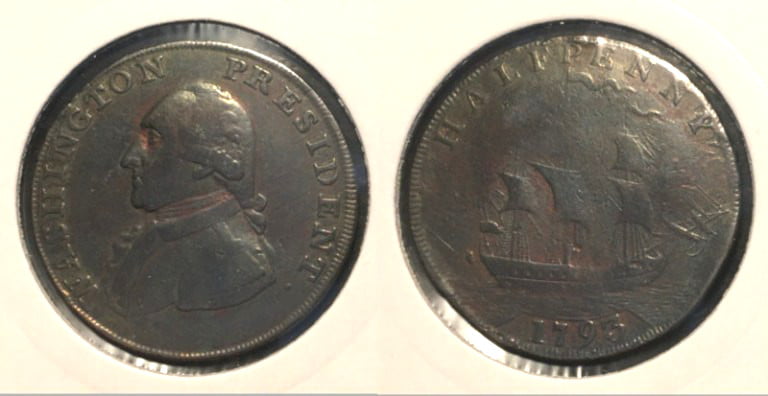This won’t be one of my normal Coin Blog posts. I wanted to show off these coins but didn’t have too much to add that hasn’t already been written by others.
Anyway, I really like these George Washington colonial coins and I’m glad I made the investment in them. Understandably, Washington was a rock star after the successful conclusion of the Revolutionary War, and there was a huge demand for merchandise bearing his image — think Notorious RBG (R.I.P.) but for the 18th and 19th centuries.
Minters got into the act by striking all kinds of coins, tokens, medals and medallions for the American hero. Some of these coins, like the 1791 Eagle Cent and the 1795 Liberty and Security Cent were struck by private minters (in England, no less, where Washington has always commanded respect – even at the height of the Revolutionary War) in the hopes of picking up a governmental contract to turn their patterns into actual currency.
Others, like the “1783” Military Bust token, the Double-Headed Washington token and the “1783” Unity States cent, were actually minted in the 1820s for collectors. The ship halfpenny was a bit of both, as the Westwood Mint in Birmingham, England simply took the obverse portrait of Washington it used in its proposed Eagle Cent coins and added a reverse image of a ship and marketed them to collectors. Of these 1783 coins, the only one known to have actually circulated at or around that date is the Georgius Triumpho token. Minted in England and modeled after the British halfpenny (in fact, historians believe the bust on the obverse is actually based on King George III and not Washington), the coin seems to be somewhat satirical, given the reverse image of Lady Liberty behind a gate consisting of thirteen bars and French fleur-de-lis (a reference to British defeat at the hands of American and France in the Revolutionary War). Either way, it’s considered to be a Washington colonial token.
Less common are tokens issued by private merchants, such as the 1795 Washington Grate Half Penny. Much like the Hard Times Tokens of the nineteenth century, these private issue tokens were issued due to a lack of small-denomination coins in England.
And some are still a mystery. For instance, historians differ as to the origins of the Washington/Success to the U.S. token. Some think it was minted in preparation for Washington’s second inauguration, while others claim it was actually produced in the 1800s after the U.S. expanded to 15 states (owing to the 15 stars on the Nova Constellatio-like reverse). Still others, including Russell Rulau (who, literally, wrote the book on tokens — multiple books, actually), think it was a gaming token. Either way, it’s a rare, gorgeous piece — and I’m not going to reveal how much I paid for mine.
In fact, George Washington colonial pieces can be quite pricey. Take the extremely rare 1792 Getz Half Dollar pattern. One of them went for $108,000 in January 2021. The Roman Head 1792 Cent is even more scare, with only about 20 in existence. I don’t think I’ll land either of those anytime soon…
Then again, it’s not like there is a shortage of George Washington coins out there to collect.









